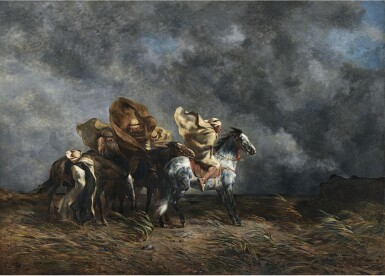Important Works from the Najd Collection
Important Works from the Najd Collection

EUGÈNE FROMENTIN | WINDSTORM ON THE ESPARTO PLAINS OF THE SAHARA
Auction Closed
October 22, 05:34 PM GMT
Estimate
400,000 - 600,000 GBP
Lot Details
Description
EUGÈNE FROMENTIN
French
1820 - 1876
WINDSTORM ON THE ESPARTO PLAINS OF THE SAHARA
signed Eug. Fromentin lower right and dated 1864 lower left
oil on canvas
117 by 163cm., 46 by 64in.
David Sellar
Louis Sarlin (sale: Galerie Georges Petit, Paris, 2 March 1918, lot 46)
Rex Ingram (1893-1950)
Mr. & Mrs. Joseph M. Tanenbaum, Toronto (by 1979)
Sale: Sotheby's, Los Angeles, 12 March 1979, lot 50
Kurt E. Schon, Ltd., New Orleans, Louisiana
Coral Petroleum, Inc., Texas (sale: Sotheby's, New York, 22 May 1985, lot 9)
Mathaf Gallery, London
Purchased from the above
Maxime du Camp, 'Salon de 1864', in Revue des Deux Mondes, 1 June 1864, no. 694-95
Léo Lagrange, 'Salon de 1864', in Gazette des Beaux-Arts, 1864, XVII, p. 20
Th. Thoré, 'Salon de 1864', in Salons de W. Burger 1861-1868, Paris, 1870, p. 87
Louis Gonse, 'Eugène Fromentin, peintre et écrivain ', in Gazette des Beaux Arts, 1878, vol. I, p. 410; 1879, vol. II, p. 288
Louis Gonse, Eugène Fromentin, peintre et écrivain, Paris, 1881, pp. 79-80, illustrated opp. p. 58 with engraving by M. Lalanne (as Le Simoon)
Victor Fournel, Les artistes français contemporains, Tours, 1884, p. 388
Henry Roujon, 'Fromentin' in Les Peintres Illustrés, Paris, 1912, no. 32, pl. IV (illustrated as Le Sirocco a l'oasis)
Prosper Darbec, Eugène Fromentin, Paris, 1926, p. 83, illustrated p. 67 (as Le Khamsin)
Henri Focillon, La Peinture au XIXe siècle, Paris, 1927, vol.II, p. 219
James Thompson & Barbara Wright, Les Orientalistes, Eugène Fromentin, Paris, 1987, p. 201, catalogued & illustrated
Caroline Juler, Najd Collection of Orientalist Paintings, London, 1991, pp. 120-21, catalogued & illustrated
‘One would think that the wind could not be painted, being a colourless and formless thing, yet it blows visibly through M. Fromentin’s picture.’
Théophile Gautier
Exhibited to great acclaim at the Paris Salon of 1864, Windstorm on the Esparto Plains of the Sahara remains one of the most enduring and striking compositions in all Orientalist art. The five riders and their mounts are depicted near Laghouat on the fringe of the Sahara in Algeria, although the precise setting could hardly be inferred from the stark scenery. Apart from the riders the only interruption to the low horizon is a series of cliffs to the right, whose rigidity only serves to heighten their vulnerability. The scene derives its power from their various reactions to the desert wind, identified by some contemporary critics as the ‘Khamsin’ or ‘Simoun’, although the artist did not make this explicit in the title. The rightmost horse, like its rider, faces into the wind with stoic determination, the horse's weight palpable and forelegs ‘like steel’ as the critic Théophile Thoré observed. The next horse is clearly in terror, the effect accentuated by its head placed at the centre of the composition. The wave-like esparto grass adds to the sense of relentless movement, but on some level also implies that the riders, like the flora, are adapted to this harsh environment and will weather the storm.
The painting powerfully expresses the ‘authentic’, lived Orientalism Fromentin sought to promote, born of his own first-hand knowledge of the desert and his respect for its way of life. This he contrasted with those he regarded as ‘bourgeois Orientalists’, who ‘composed like inventories’ in the comfort of the studio. The painting’s genesis can be traced to Lisière d’oasis pendant le sirocco of 1859, one of five paintings Fromentin showed at that year’s Salon. Described by the critic Louis Gonse as Fromentin’s ‘Salon-roi’, Fromentin won great success that year, and was decorated with a first class medal and the Croix de la Légion d’Honneur. Now lost, Lisière d’oasis pendant le 'sirocco' is known from an engraving by Maxime Lalanne (fig. 1) and clearly shared with the present composition the low horizon and dynamic sky. Gonse considered Fromentin’s 1859 work a masterpiece, a work of art that inspired Theophile Gautier’s observation cited above. This quote, however, could equally apply to the present work. Limited like all artists to showing two paintings at the Salon of 1864, Fromentin clearly intended to make an impact with the present work.
Through his subsequent extended stays in Biskra, Fromentin secured his reputation as one of the leading figures of the Orientalist genre. In fact, he published two illustrated travel books, Un été dans le Sahara (1857) and Une année dans le Sahel (1859). The combined repertoire of his art and accompanying texts explain why Fromentin has become the subject of numerous recent critical studies, which document his role as one of the earliest and most significant theorists of Orientalism.
The cool tones of the present work, and Fromentin’s painted oeuvre more generally, are indicative of his other major observation: that the intense light of North Africa reduced all colours to grey: ‘Grey, here the advent and triumph of grey,’ Fromentin would write. The tempered palette, rolling storm clouds, and slate-grey sky seen in many of Fromentin’s mature compositions reflect his attempts to explore the subtleties of this monochromatic landscape, as well as his lifelong admiration of Dutch painting and the later works of Corot. It is the suppression of harsh tones and this ‘cool view’ of his subjects that differentiates Fromentin’s equestrian works from those frenzied, raucously coloured compositions of Delacroix and Chassériau (fig. 2).
A second version of the composition measuring 55 by 65.5cm and with three riders and their horses, was sold at Sotheby’s Orientalist sale in 2012 and is now in the Shafik Gabr Collection (fig. 3).
